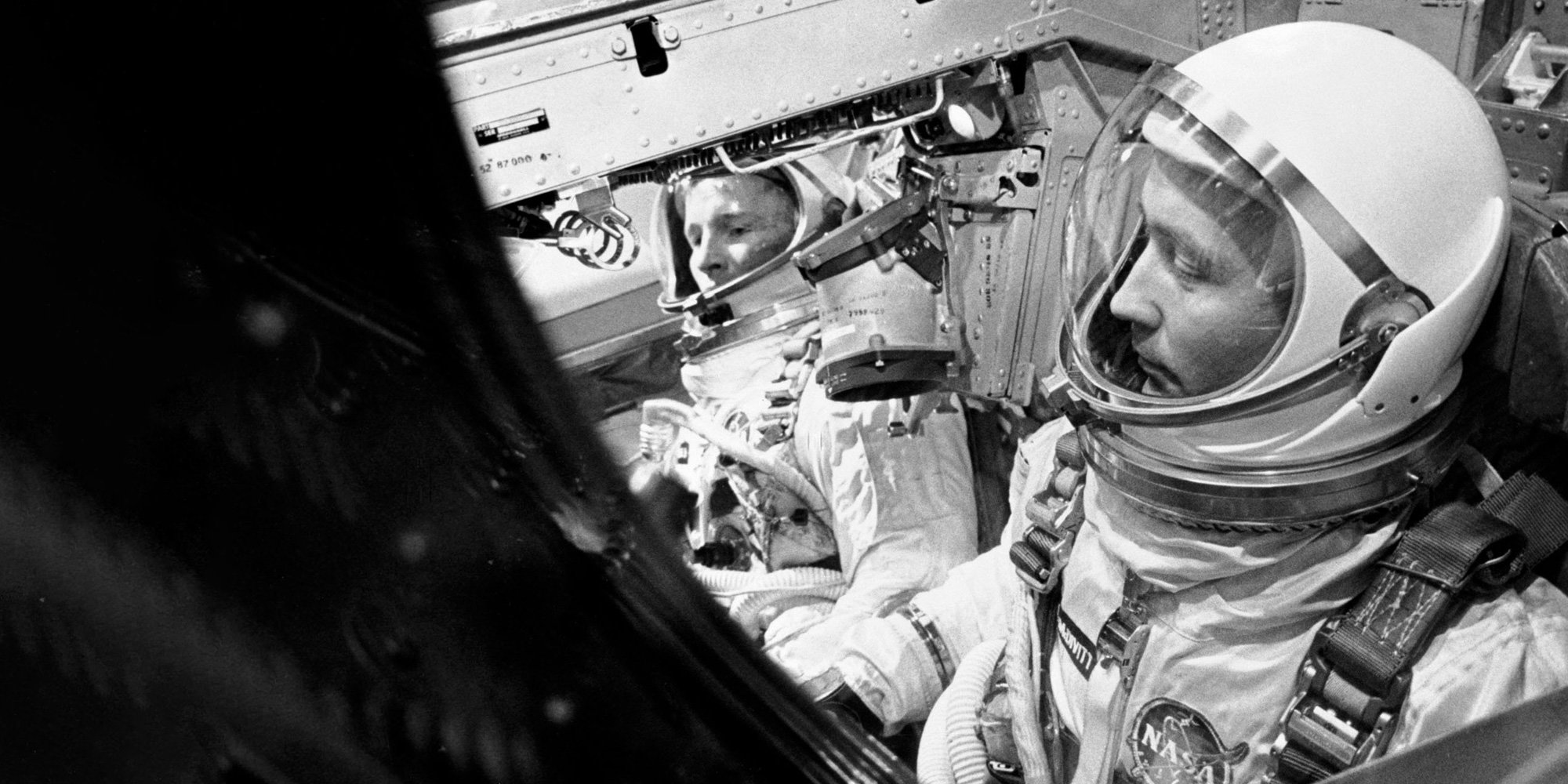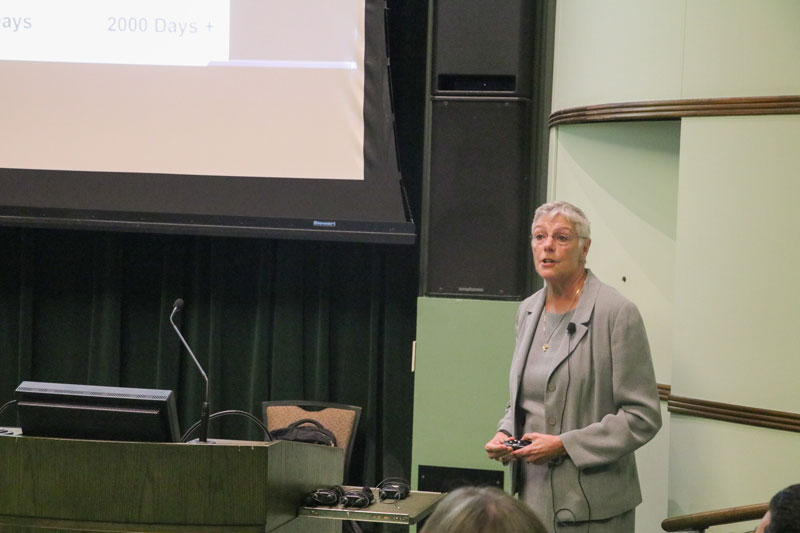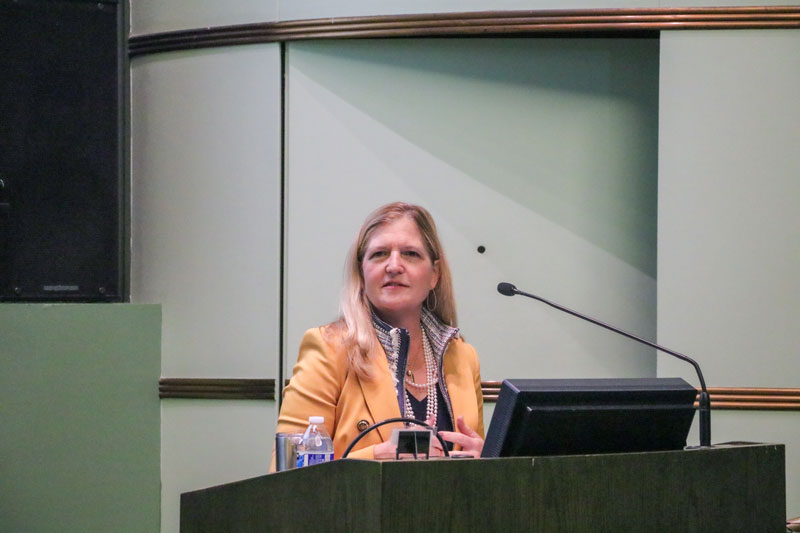
Honoring a Legacy
Jim McDivitt Memorial Symposium gathers experts in space to reflect on our history and look toward the exciting future of space exploration

Jim McDivitt Memorial Symposium gathers experts in space to reflect on our history and look toward the exciting future of space exploration
The past, present, and future converged at the recent McDivitt Symposium. Gathering together to honor the passing of renowned alumni, Jim McDivitt, the symposium represented a momentous occasion to collectively reflect on the rich historical legacy held within Michigan Aerospace and within the space industry while setting our sights on a bright future.
Bringing together attendees, guest speakers, and panelists, the symposium fostered collaborative discussions on the development of the space industry and Jim McDivitt’s remarkable contributions. As the astronaut commander on the Gemini IV and Apollo 9 missions, as well as serving as the Manager of the Apollo Spacecraft Program and the program manager for Apollo 12, 13, 14, 15, and 16, Jim was the perfect example of “the right stuff,” as noted by speaker John LaFond, and helped shape the public perception of what space travel is today.
In honor of Jim’s legacy and to continue his pioneering work in aerospace engineering, the symposium provided a platform to explore how we can embody his innovative spirit and propel ourselves forward. While setting the sights on the dynamic and promising future of space exploration. We gathered together to map a path towards the stars, while reflecting on the past accomplishments and triumphs that brought us here.
“It was a privilege to attend the inaugural McDivitt symposium and to listen to the leaders in the field comment on the past, present, and future of space. I was grateful to have the opportunity to outline a vision for Michigan’s role in the development of next-generation propulsion technologies for fast transits throughout the solar system,” said Ben Jorns, Associate Professor at Michigan Aerospace after the symposium concluded.
As an alumnus of our department, Jim McDivitt’s remarkable journey began when he graduated first in his class in 1959, setting an enduring standard of academic excellence and serving as a pioneering figure of space exploration. Prior to his association with our department, McDivitt pursued his passion for aviation, enlisting in the Air Force in 1951. He became the first graduate of the U.S. Air Force Experimental Test Flight Program and the only member recruited for the future space pilots.
In 1962, McDivitt was selected as an astronaut by NASA, and was chosen as command pilot of Gemini 4, making him the first U.S. astronaut to command his initial spaceflight. This historic mission, alongside Edward H. White, included the first U.S. spacewalk, spanning four days and completing 66 orbits. His legacy further expanded with his command of Apollo 9 in March 1969, the first crewed flight test of the Apollo lunar module. The mission played a pivotal role in evaluating essential components of future moon landings, including the lunar module engines, backpack life support systems, and navigation instruments.
After his accomplishments in space flight, he returned to Earth to work with both NASA and the University of Michigan, collaborating closely with faculty and alumni before retiring in 1972. Of his many contributions to his alma mater, the most visible is likely the rare moon rock he donated to Michigan Aerospace, which is still on display in the Atrium of the Francois-Xavier Bagnoud building which houses Michigan Aerospace.
McDivitt’s remarkable career garnered well-deserved recognition from the aerospace community and the University of Michigan. His honors include two NASA Distinguished Service Medals, numerous honorary doctorates (including one in aeronautical science from the University of Michigan), induction into the International Space Hall of Fame, and a multitude of other distinctions.
Without a doubt, Jim McDivitt devoted his heart and soul to the aerospace industry, leaving an enduring legacy. Both Michigan Aerospace and the landscape of American space exploration owe a profound debt of gratitude to his exceptional contributions.
In order to gaze into a bright future, you must review successes and failures that landed space exploration where it is today. It is undeniable that space was an unknown and unexplored landscape in the eyes of engineers and scientists alike, including Jim Mcdivitt and others of his time.
The early days of space travel presented numerous challenges, each demanding discovery and resolution. While space and the course to get there were full of unknowns, it was solutions to these problems that made it all possible. The questions presented: what problems do we have to solve in order to go to space and what happens to humans in space? What are the game changers here?
Addressing these complex questions, esteemed panelist Dr. Kathy Clark, who served as chief scientist at NASA for both the Human Exploration and Development Space Enterprise and the International Space Station, reflected on her time at NASA, saying “we’ve now gone from dreaming of going into a long-term space flight into actually trying to solve the problems necessary to do it.”
One of the first obstacles to overcome, especially for first-time astronauts, is the risk of nausea, because “throwing up in your suit is a really bad day,” Dr. Clark remarked to the audience. While this is indeed a problem the larger issue with this is notably dehydration if the symptoms persist for long enough. Another pressing issue is radiation which not only impacts the health of those onboard but also affects spacecraft hardware and software within the space capsule.

Beyond these hurdles, researchers and scientists grappled with changes in bone density, muscular structure, the nervous system, blood flow, immune system, and wound healing. The construction of the space station became a pivotal endeavor, aimed at testing innovative solutions through dietary changes, varied exercise methods, and the use of nutraceuticals.
“We were about to embark on building something that had never been built in an environment we really didn’t understand well. We actually had to invent some of the equipment for the construction itself and we did it in 14 languages,” Dr. Clark explained in excitement. She continued on to state that while lots of things went wrong during the difficult process, it was equally rewarding because they “pulled it off.”
Notably, additional challenges and obstacles needed to be solved throughout the early years of space exploration. John Tylko, Chief Innovation Officer at Aurora Flight Sciences, elaborated on these challenges, which included the development of guidance computers, user interfaces, executive overflow systems to prioritize essential tasks in-flight, and the concept of a digital autopilot system. These innovations laid the foundation for the remarkable present, propelling the aerospace industry forward into the future, despite the vastly different landscape of digital engineering that we have today.
In today’s dynamic world, the realm of research beyond Earth’s atmosphere is no longer confined to NASA alone. A surge of new companies and organizations has successfully launched initiatives, redefining the very essence of space exploration. These evolving times are shaping a framework of collaboration, underscoring the importance of collective efforts in exploring the unknown.
Through this, the panel discussion of present day space travel unearthed a vast array of topics that were brought into discussion. Everything from the history and current uses of the International Space Station and it becoming a beacon of diversity and collaboration, the recent discovery of planets around other stars within the last 10 years, the Artemis Mission which is focused on going back to the moon, the role of industry development in regards to international space travel, and the risks involved in the unforgiving space landscape.
During the symposium, Debra Facktor highlighted the recent strides at Airbus and their partnership with the European Space Agency (ESA), emphasizing the significance of collaborative ventures such as the NASA Artemis moon program. “If we all spoke one language, such as the rocket equation and if you really thought about math and science as languages, then you can see that these languages bridge us across culture, to do what we want to do together,” she noted.

She continued on, going into detail about Starlab, Airbus’ collaboration with Voyager Space, to look into a new generation space station. This has gained interest from NASA, ESA and other countries to look into what is possible and what the private space industry can do on their own while the government is a customer.
Addressing the idea of partnership between corporations and governmental bodies, panelist Mike Hess, Deputy Associate Administrator of Mission Support at NASA, posed critical questions about the evolving role of NASA in a changing world. He highlighted the collaborative efforts between NASA and SpaceX as an example of effective teamwork, emphasizing joint risk assessment and problem-solving protocols.
This type of partnership has begun branching out to new companies involved in space travel such as Boeing, Airbus, Blue Origin, and even smaller startup companies around the world beginning to take part.
Robert Gitten, SLD Systems Integrator for Blue Origins Lunar Transportation, added that their vision at Blue Origin is millions of people living and working in space for the benefit of Earth. They have set a goal to reduce the cost that goes along with accessing space and utilizing in-space resources while inspiring the next generation.
Gitten’s insights traced the trajectory of progress from the Apollo era where learning how to fly was the main goal to accomplish the challenges of construction and collaboration in the station era. He finished by explaining that we now are in the era of everything, that the door is open, and all kinds of people are coming through with new opportunities for everyone.
The general consensus between attendees was a resounding “collaboration forward’ mentality at the symposium. The current day projects revolve around working together and creating new and exciting ways to develop the future.
In a world brimming with uncertainty, the closing panel delved into their personal journeys and marveled at the incredible strides the industry has taken. Dr. Bonnie J. Dunbar, Professor and John and Bea Slattery Chair with the Texas A&M Aerospace Engineering Department and retired Mission Specialist Astronaut, initiated the discussion with a thought-provoking reflection, “perspective and history is important for interpreting the present and planning for the future.”
The panelists and audience explored the potential of a generation capable of pursuing multiple mission objectives, ranging from a return to the Moon or venturing to Mars, to being able to support Earth science to better characterize what’s happening on our own planet.
Matt Donovan, Senior Director of New Shepard System Architecture at Blue Origin, highlighted the “Overview Effect” in regards to Earth science discovery. This phenomenon marks a shift in astronauts’ consciousness upon viewing the Earth from space, fostering a profound global awareness and advocacy for the planet’s significance.
Additionally, other challenges and discoveries were discussed. Things like the problem with space dust and the razor sharp edges that are known to impede space equipment and draw concern to astronaut health. Sustainability also emerged as a focal point, particularly in terms of strategizing how humans could sustainably “live off the land” on different planets.
Navigating these challenges necessitates an ongoing exploration of potential solutions, with continuous technological advancements propelling us towards sustainable human habitation on other planets. The significance of collaborative efforts were emphasized, underscoring the importance of unity and innovation.
Reflecting on the success of the symposium, Aaron Johnson, Michigan Aerospace Assistant Professor and panel moderator, said “the symposium really emphasized the important role that Michigan has had in preparing leaders in spaceflight—from Jim McDivitt to our current graduates. Michigan alums have critical roles in this next generation of private and public spaceflight. And with our faculty’s participation in the U-M Space Institute and our strategic thrust on commercial spaceflight, there’s a lot of excitement for the future!”
While the viewpoints of Michigan Aerospace professors may vary, there is a resounding focus on the prospect of a journey to Mars. Yet, the challenges associated with this ambition are undeniably substantial. At the McDivitt Symposium, Associate Professor Ben Jorns relayed the complexities of electric propulsion and the ability to travel quickly through space.
Additionally, while the University itself may be the perfect place for research like this to take place, however it cannot operate in isolation. Working closely with industry and government partners for support would be a key factor in advocating for certain capabilities. Associate Professor Mirko Gamba stated that recognizing that our strengths are the collaborative spaces that have been created within the University in the form of Institutes.
As education remains the driving force at UM, research continues to be an integral part of the educational journey within the Michigan Aerospace Department. Research and education are the twin engines that fuel innovation and engagement. A great example of this can be found in the department’s unwavering commitment to sustainable aviation, which then also applies to sustainability in space.
Sustainable aviation being a main thrust within the aerospace department and a growing concern in the industry, innovative new concepts for these advancements to be broadened into space will be a driving force for the future. This push will continue to be a collaborative effort going forward. With creative new ways and dynamic partnerships, anything could be possible.